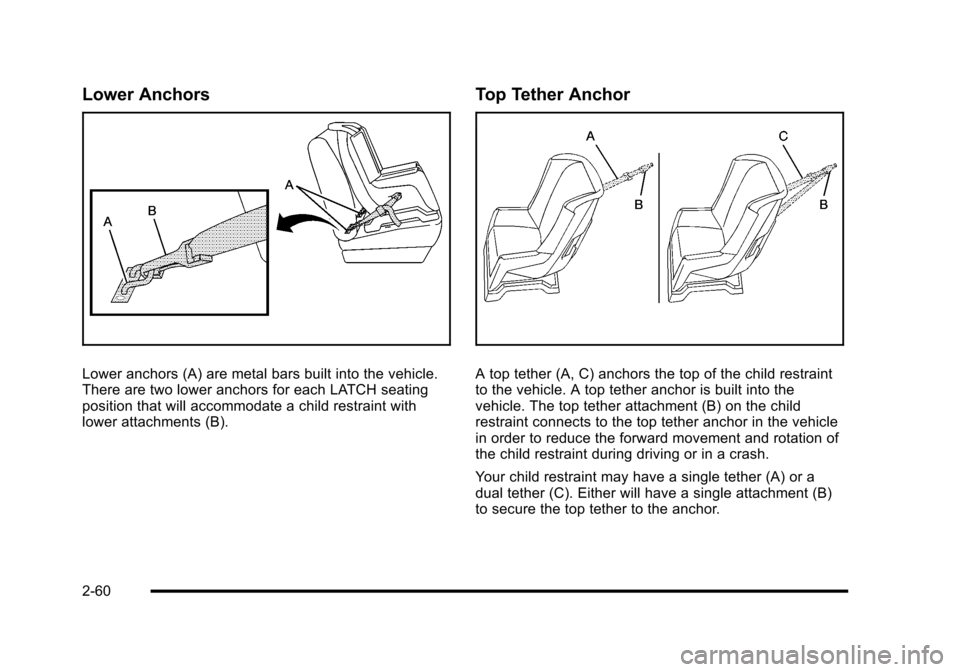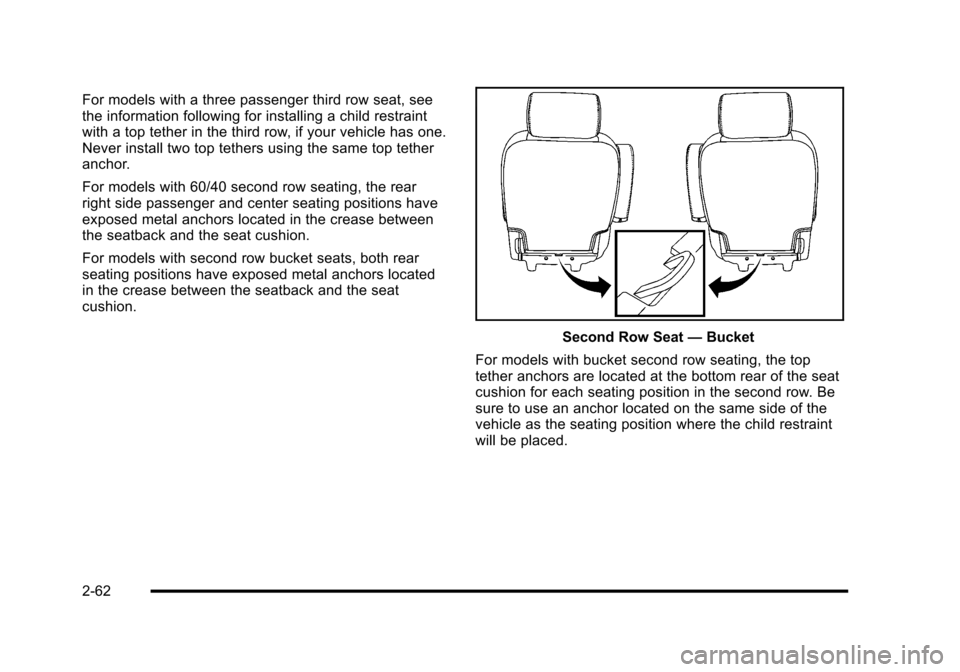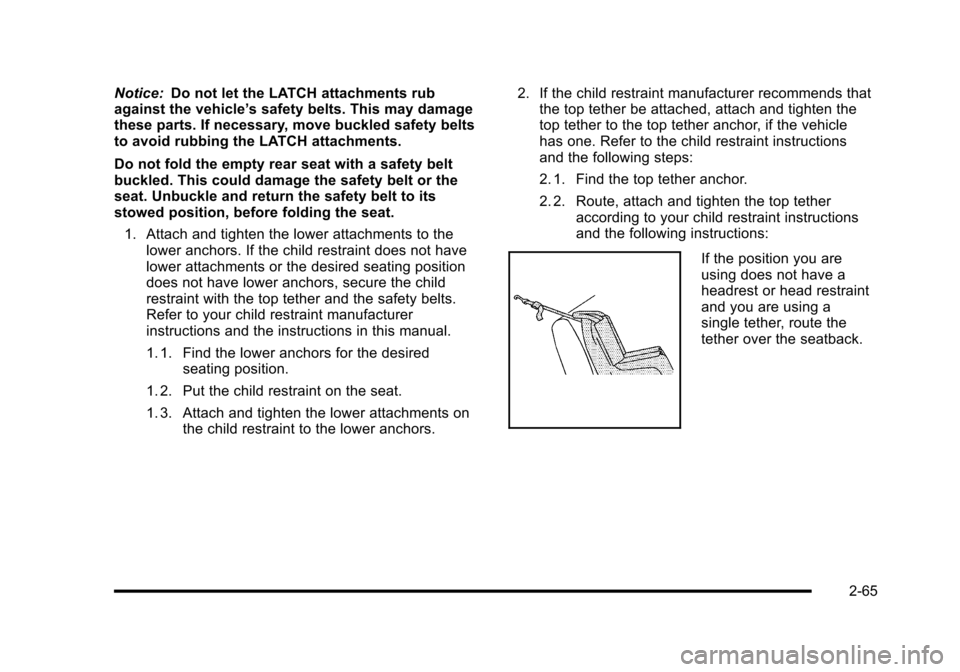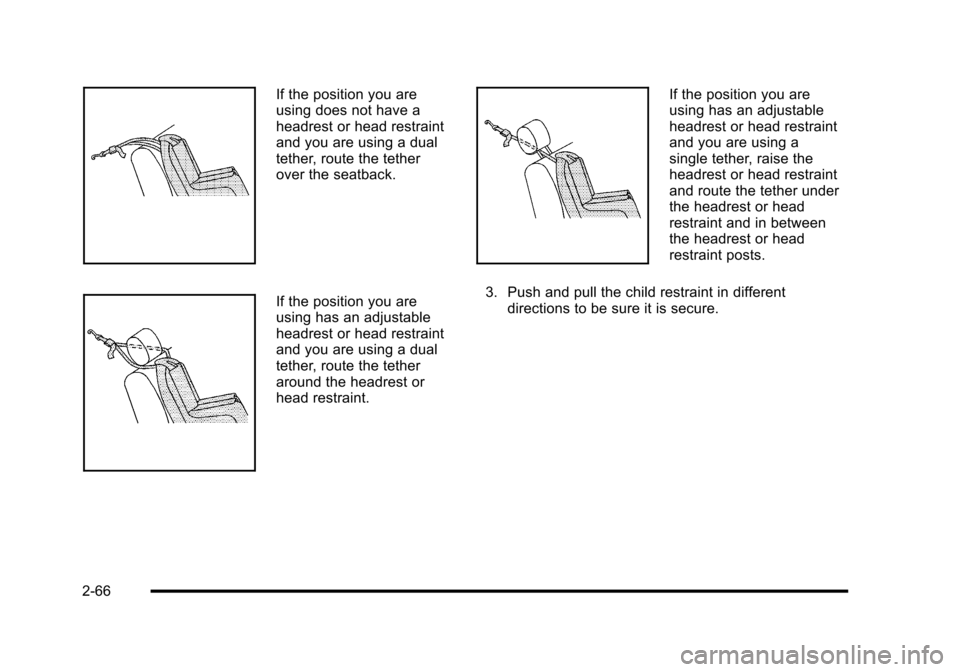CADILLAC ESCALADE 2010 3.G Owners Manual
Manufacturer: CADILLAC, Model Year: 2010, Model line: ESCALADE, Model: CADILLAC ESCALADE 2010 3.GPages: 616, PDF Size: 39.41 MB
Page 91 of 616

{WARNING:
A child in a child restraint in the center front seat
can be badly injured or killed by the frontal
airbags if they inflate. Never secure a child
restraint in the center front seat. It is always better
to secure a child restraint in a rear seat.
Do not use child restraints in the center front seatposition.
When securing a child restraint in a rear seatingposition, study the instructions that came with your childrestraint to make sure it is compatible with this vehicle.
Wherever a child restraint is installed, be sure to securethe child restraint properly.
Keep in mind that an unsecured child restraint canmove around in a collision or sudden stop and injurepeople in the vehicle. Be sure to properly secure anychild restraint in your vehicle—even when no childis in it.
Lower Anchors and Tethers for
Children (LATCH)
The LATCH system holds a child restraint duringdriving or in a crash. This system is designed to makeinstallation of a child restraint easier. The LATCHsystem uses anchors in the vehicle and attachmentson the child restraint that are made for use with theLATCH system.
Make sure that a LATCH-compatible child restraintis properly installed using the anchors, or use thevehicle's safety belts to secure the restraint, followingthe instructions that came with that restraint, and alsothe instructions in this manual. When installing a childrestraint with a top tether, you must also use either thelower anchors or the safety belts to properly secure thechild restraint. A child restraint must never be attachedusing only the top tether and anchor.
In order to use the LATCH system in your vehicle, youneed a child restraint that has LATCH attachments.The child restraint manufacturer will provide you withinstructions on how to use the child restraint and itsattachments. The following explains how to attach achild restraint with these attachments in your vehicle.
Not all vehicle seating positions or child restraints havelower anchors and attachments or top tether anchorsand attachments.
2-59
Page 92 of 616

Lower Anchors
Lower anchors (A) are metal bars built into the vehicle.There are two lower anchors for each LATCH seatingposition that will accommodate a child restraint withlower attachments (B).
Top Tether Anchor
A top tether (A, C) anchors the top of the child restraintto the vehicle. A top tether anchor is built into thevehicle. The top tether attachment (B) on the childrestraint connects to the top tether anchor in the vehiclein order to reduce the forward movement and rotation ofthe child restraint during driving or in a crash.
Your child restraint may have a single tether (A) or adual tether (C). Either will have a single attachment (B)to secure the top tether to the anchor.
2-60
Page 93 of 616

Some child restraints with top tethers are designed foruse with or without the top tether being attached. Othersrequire the top tether always to be attached. In Canada,the law requires that forward-facing child restraints havea top tether, and that the tether be attached. Be sure toread and follow the instructions for your child restraint.
If the child restraint does not have a top tether, onecan be obtained, in kit form, for many child restraints.Ask the child restraint manufacturer whether or not a kitis available.
Lower Anchor and Top Tether Anchor
Locations
Second Row—60/40
j(Lower Anchor):Seating positions withtwo lower anchors.
i(Top Tether Anchor):Seating positions withtop tether anchors.
Second Row—Bucket
j(Lower Anchor):Seating positions withtwo lower anchors.
i(Top Tether Anchor):Seating positions withtop tether anchors.
Third Row—ThreePassenger
i(Top Tether Anchor):Seating positions with toptether anchors. There isone top tether anchor thatcan be used for either thethird row center or driverside seating position butnot both at the same time.
2-61
Page 94 of 616

For models with a three passenger third row seat, seethe information following for installing a child restraintwith a top tether in the third row, if your vehicle has one.Never install two top tethers using the same top tetheranchor.
For models with 60/40 second row seating, the rearright side passenger and center seating positions haveexposed metal anchors located in the crease betweenthe seatback and the seat cushion.
For models with second row bucket seats, both rearseating positions have exposed metal anchors locatedin the crease between the seatback and the seatcushion.
Second Row Seat—Bucket
For models with bucket second row seating, the toptether anchors are located at the bottom rear of the seatcushion for each seating position in the second row. Besure to use an anchor located on the same side of thevehicle as the seating position where the child restraintwill be placed.
2-62
Page 95 of 616

Second Row Seat—60/40
For models with 60/40 second row seating, the toptether anchors are located at the bottom rear of the seatcushion for each seating position in the second row. Besure to use an anchor located on the same side of thevehicle as the seating position where the child restraintwill be placed.
Third Row Seat—Three Passenger
For vehicles with a three passenger third row seat,there is one top tether anchor located at the bottom rearof the seat cushion that can be used for either the thirdrow center or driver side seating position. Never installtwo top tethers using the same top tether anchor.
Do not secure a child restraint in a position without atop tether anchor if a national or local law requires thatthe top tether be attached, or if the instructions thatcome with the child restraint say that the top tether mustbe attached.
2-63
Page 96 of 616

According to accident statistics, children and infants aresafer when properly restrained in a child restraintsystem or infant restraint system secured in a rearseating position. SeeWhere to Put the Restraintonpage 2!57
Securing a Child Restraint Designed for
the LATCH System
{WARNING:
If a LATCH-type child restraint is not attached to
anchors, the child restraint will not be able to
protect the child correctly. In a crash, the child
could be seriously injured or killed. Install a
LATCH-type child restraint properly using the
anchors, or use the vehicle's safety belts to
secure the restraint, following the instructions that
came with the child restraint and the instructions
in this manual.
{WARNING:
Do not attach more than one child restraint to a
single anchor. Attaching more than one child
restraint to a single anchor could cause the
anchor or attachment to come loose or even
break during a crash. A child or others could be
injured. To reduce the risk of serious or fatal
injuries during a crash, attach only one child
restraint per anchor.
{WARNING:
Children can be seriously injured or strangled if a
shoulder belt is wrapped around their neck and
the safety belt continues to tighten. Buckle any
unused safety belts behind the child restraint so
children cannot reach them. Pull the shoulder belt
all the way out of the retractor to set the lock,
if your vehicle has one, after the child restraint
has been installed.
2-64
Page 97 of 616

Notice:Do not let the LATCH attachments rubagainst the vehicle’s safety belts. This may damagethese parts. If necessary, move buckled safety beltsto avoid rubbing the LATCH attachments.
Do not fold the empty rear seat with a safety beltbuckled. This could damage the safety belt or theseat. Unbuckle and return the safety belt to itsstowed position, before folding the seat.
1. Attach and tighten the lower attachments to thelower anchors. If the child restraint does not havelower attachments or the desired seating positiondoes not have lower anchors, secure the childrestraint with the top tether and the safety belts.Refer to your child restraint manufacturerinstructions and the instructions in this manual.
1. 1. Find the lower anchors for the desiredseating position.
1. 2. Put the child restraint on the seat.
1. 3. Attach and tighten the lower attachments onthe child restraint to the lower anchors.
2. If the child restraint manufacturer recommends thatthe top tether be attached, attach and tighten thetop tether to the top tether anchor, if the vehiclehas one. Refer to the child restraint instructionsand the following steps:
2. 1. Find the top tether anchor.
2. 2. Route, attach and tighten the top tetheraccording to your child restraint instructionsand the following instructions:
If the position you areusing does not have aheadrest or head restraintand you are using asingle tether, route thetether over the seatback.
2-65
Page 98 of 616

If the position you areusing does not have aheadrest or head restraintand you are using a dualtether, route the tetherover the seatback.
If the position you areusing has an adjustableheadrest or head restraintand you are using a dualtether, route the tetheraround the headrest orhead restraint.
If the position you areusing has an adjustableheadrest or head restraintand you are using asingle tether, raise theheadrest or head restraintand route the tether underthe headrest or headrestraint and in betweenthe headrest or headrestraint posts.
3. Push and pull the child restraint in differentdirections to be sure it is secure.
2-66
Page 99 of 616

Securing a Child Restraint in a Rear
Seat Position
When securing a child restraint in a rear seatingposition, study the instructions that came with the childrestraint to make sure it is compatible with this vehicle.
If the child restraint has the LATCH system, seeLowerAnchors and Tethers for Children (LATCH)onpage 2!59for how and where to install the childrestraint using LATCH. If a child restraint is secured inthe vehicle using a safety belt and it uses a top tether,seeLower Anchors and Tethers for Children (LATCH)on page 2!59for top tether anchor locations.
Do not secure a child seat in a position without a toptether anchor if a national or local law requires that thetop tether be anchored, or if the instructions that comewith the child restraint say that the top strap mustbe anchored.
In Canada, the law requires that forward-facing childrestraints have a top tether, and that the tether beattached.
If the child restraint does not have the LATCH system,you will be using the safety belt to secure the childrestraint in this position. Be sure to follow theinstructions that came with the child restraint.Secure the child in the child restraint when andas the instructions say.
If more than one child restraint needs to be installed inthe rear seat, be sure to readWhere to Put theRestraint on page 2!57.
The vehicle's lap!shoulder belts for the first and secondrow seating positions are equipped with free!falling latchplates. If the vehicle has a third row, the lap!shoulderbelts have either free!falling or cinching latch plates.
2-67
Page 100 of 616

Use the following pictures to determine the latch platestyle:
Free!Falling Latch Plate
Cinching Latch Plate
1. Put the child restraint on the seat.
2. Pick up the latch plate, and run the lap andshoulder portions of the vehicle's safety beltthrough or around the restraint. The child restraintinstructions will show you how.
For third row seating positions, with cinching latchplates, tilt the latch plate to adjust the belt ifneeded.
2-68